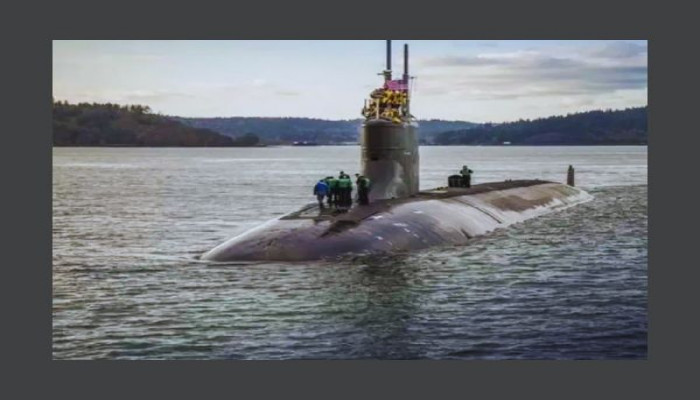India ramps up naval power with underground nuclear submarine base to counter China
- In Reports
- 09:48 PM, Apr 07, 2025
- Myind Staff
India is nearing the completion of a highly secretive naval base near Rambilli, a coastal village in Andhra Pradesh, around 50 kilometers from the Eastern Naval Command in Visakhapatnam. Scheduled for commissioning in 2026, this base marks a crucial advancement in India's maritime defense posture. The development is part of Project Varsha, a classified initiative aimed at enhancing the country's nuclear deterrence capabilities amid rising tensions with China and increased Chinese influence in neighboring countries.
This underground facility is designed to discreetly house India’s nuclear-powered ballistic missile submarines (SSBNs), allowing them to enter and exit the Bay of Bengal with minimal risk of detection by enemy satellites. The location and design enable stealth operations, critical for maintaining the integrity of India’s second-strike capability.
The move comes at a time when India is closely monitoring China's expanding regional footprint, including potential military cooperation with Bangladesh. Intelligence reports suggest China may assist Bangladesh in building an air base in Lalmonirhat, near India’s Siliguri Corridor—also known as the "Chicken’s Neck"—a narrow land stretch that connects mainland India to its northeastern states and lies in proximity to Nepal, Bhutan, Bangladesh and China.
Rambilli
The Rambilli naval base, forming the heart of Project Varsha, features a vast network of underground tunnels and submarine pens. These structures will allow India’s SSBN fleet to operate undetected, enhancing the strategic depth of its nuclear triad. According to a senior defence official quoted in a Times of India report, “The first phase of the Rambilli base under Project Varsha is almost complete. After commissioning in 2026, it can be expanded and upgraded in phases, much like what is underway at the Karwar base under Project Seabird.”
The facility leverages the natural underwater topography, providing depth and concealment that are ideal for covert submarine movements. Much like China’s fortified Hainan Island base, Rambilli is built for stealth, making it difficult for adversaries to track movements in and out of the base.
This initiative has faced delays due to environmental, technological, and logistical challenges, but its nearing completion signals a major leap in India's maritime deterrent.
Strengthening the Submarine Fleet
India is also set to bolster its submarine fleet. The INS Aridhaman, the third nuclear-powered submarine equipped with ballistic missiles, is expected to join the Indian Navy in 2025. Weighing about 7,000 tonnes, Aridhaman is larger and more powerful than its predecessors—INS Arihant and INS Arighaat—and capable of carrying more K-4 nuclear-capable ballistic missiles, each with a range of 3,500 kilometers.
This addition will significantly reinforce India’s nuclear triad—the ability to deliver nuclear weapons from land, sea, and air. Furthermore, a fourth SSBN is under construction under the ₹90,000 crore Advanced Technology Vessel (ATV) project. This new class of submarines will weigh approximately 13,500 tonnes and be powered by next-generation 190 MW pressurized light-water reactors, replacing the current 83 MW designs.
Parallelly, India has initiated construction on six nuclear-powered attack submarines (SSNs) focused on conventional warfare. In October of the previous year, the Cabinet Committee on Security approved the first two SSNs, each weighing 9,800 tonnes, with an allocated budget of ₹40,000 crore.
Securing the Western Coast
While the Rambilli base enhances India’s presence on the eastern front, the western coast is also receiving substantial upgrades under Project Seabird. The Karwar naval base in Karnataka is being expanded to become one of the largest naval facilities in the Indian Ocean region.
Defence Minister Rajnath Singh recently inaugurated key operational, logistics, and repair infrastructure at the Karwar base, with over ₹2,000 crore invested so far. A senior naval official noted, “Phase-IIA of Project Seabird will enable Karwar to berth 32 warships. The inner harbour is ready. Work on the outer harbour, with the requisite breakwaters and jetties, is in progress.”
Upon completion of Phase IIB, the 25-kilometer-long base will be capable of supporting 50 warships and submarines, along with 40 auxiliary vessels. The base will feature a naval air station, dry docks and full logistical facilities. This expansion will also relieve congestion from Mumbai’s overburdened naval harbor.
China’s Reach Near the Siliguri Corridor
India’s strategic moves are unfolding against a backdrop of regional friction and concern. Reports indicate that China may assist Bangladesh in developing an airfield in Lalmonirhat, a location uncomfortably close to India’s Siliguri Corridor. This corridor, just a few kilometers wide in places, is a crucial passage that connects India's northeastern states to the rest of the country.
Though no Chinese aircraft have yet been stationed in the area, the possibility has set off alarm bells in New Delhi. “Any such proposal has serious security implications for India as the entire northeast, Sikkim and West Bengal will be vulnerable,” say Bangladesh watchers.
India’s apprehensions are compounded by China’s growing presence in the Indian Ocean and its involvement in infrastructure projects across South Asia. The potential establishment of a Chinese-supported airfield near the Chicken’s Neck could further challenge India's strategic balance in the region.
Pakistan Eyes Bangladesh
Further complicating the regional landscape, Pakistan is also stepping up its diplomatic outreach to Bangladesh. Foreign Secretary Amna Baloch is set to visit Dhaka on April 17, followed by Foreign Minister Ishaq Dar on April 24. These visits will mark the first high-level engagements between Pakistan and Bangladesh since 2012 and are expected to result in the signing of several agreements.
This renewed engagement is being closely monitored by Indian strategic planners, as Bangladesh becomes a growing point of interest for multiple regional powers







Comments